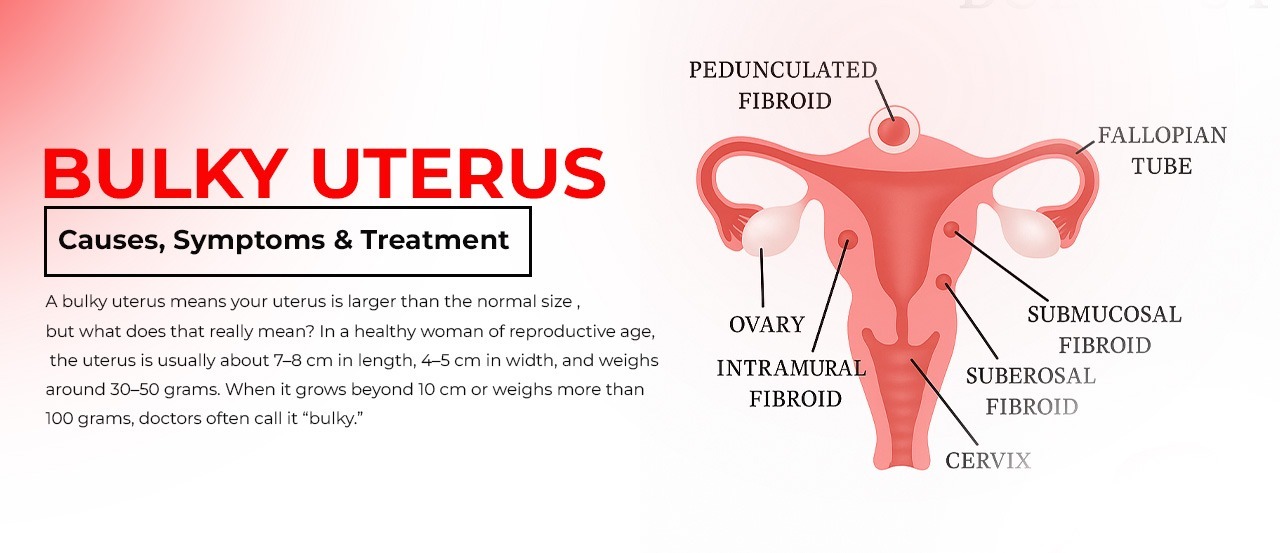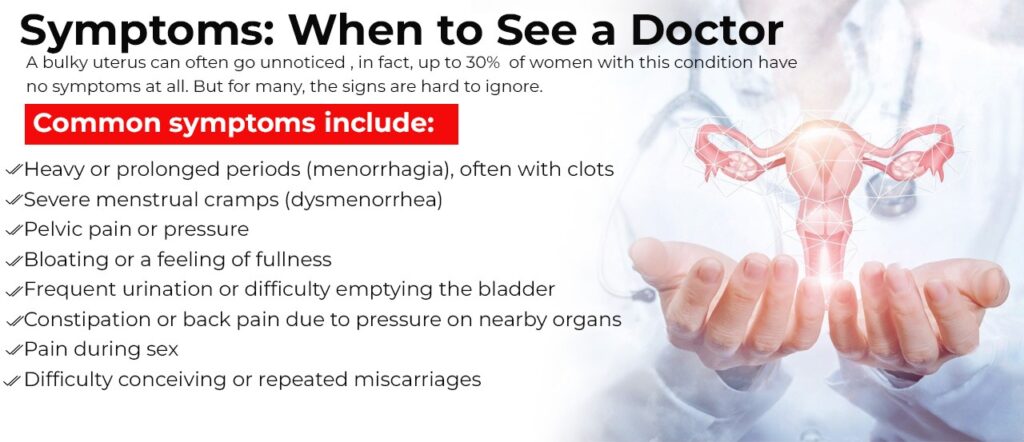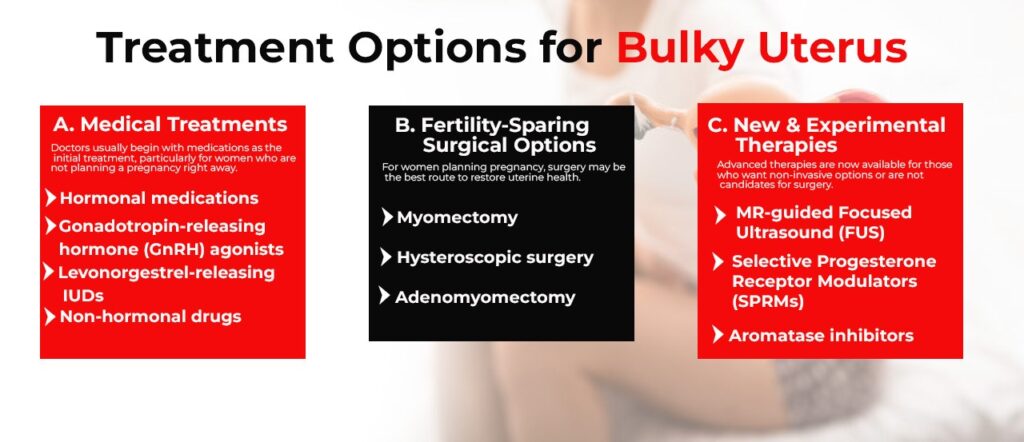Bulky Uterus: Causes, Symptoms & Treatment

Introduction
Did you know that nearly 1 in 5 women of reproductive age are diagnosed with a bulky uterus, often without even knowing it? While the term may sound alarming, a bulky uterus simply means that the size of the uterus is larger than normal, and it can happen due to several reasons, like fibroids, adenomyosis, or hormonal imbalances.
For many women, especially those trying to conceive, this condition can be confusing and emotionally overwhelming. Research shows that over 35% of women with unexplained infertility have some form of uterine abnormality, and an enlarged uterus is one of them.
What is a Bulky Uterus?
A bulky uterus means your uterus is larger than normal size, but what does that really mean? In a healthy woman of reproductive age, the uterus is usually about 7–8 cm in length, 4–5 cm in width, and weighs around 30–50 grams. When it grows beyond 10 cm or weighs more than 100 grams, doctors often call it “bulky.”
This condition isn’t a disease by itself; it’s usually a result of something else going on inside your body. Common causes include fibroids, adenomyosis, or hormonal issues, which can all lead to an increase in uterine size.
A bulky uterus is often discovered during a routine ultrasound or pelvic exam, and in many cases, women don’t even know they have it until they face symptoms like heavy bleeding or trouble conceiving.
Common Causes of Bulky Uterus
A bulky uterus doesn’t just happen on its own; it’s usually caused by one or more underlying conditions. Let’s understand the most common reasons behind it:
Fibroids (Uterine Leiomyomas)
Fibroids are non-cancerous growths of the uterus and the leading cause of a bulky uterus, found in up to 70–80% of women by age 50. These growths can vary in size, from as small as a seed to as large as a melon, and often cause the uterus to expand abnormally. Depending on where they grow (inside, in the wall, or on the surface), fibroids can cause heavy periods, pelvic pain, and fertility issues. Large fibroids can cause the uterus to appear enlarged and may alter its natural shape.
Adenomyosis
Adenomyosis occurs when the tissue that normally lines the uterus begins to grow within its muscular wall. This condition affects up to 20–30% of women and causes the uterus to become soft, spongy, and enlarged. It often leads to severe menstrual cramps, heavy bleeding, and a globular, bulky uterus. Adenomyosis is a silent disruptor of fertility, often going undiagnosed without imaging, like an ultrasound or an MRI.
Endometrial Hyperplasia
This is an abnormal thickening of the uterine lining, often caused by unbalanced estrogen levels. It can lead to irregular or heavy bleeding and may increase the overall size of the uterus. Though less common, it’s important to rule out if you have unexplained bleeding or a bulky uterine appearance.
Hormonal Imbalances & Other Factors
Conditions like PCOS, early menopause, or prolonged estrogen exposure can cause the uterus to grow abnormally. Obesity, certain medications, or past pregnancies may also contribute to uterine enlargement. Occasionally, structural issues such as a double uterus, long-term infections, or non-cancerous growths can cause the uterus to become enlarged. Many women don’t experience symptoms until the uterus becomes significantly enlarged, which is why routine checkups and scans at centres like Imprimis IVF are key to early detection and treatment.
Symptoms of Bulky Uterus

A bulky uterus can often go unnoticed; in fact, up to 30% of women with this condition have no symptoms at all. But for many, the signs are hard to ignore.
Common symptoms include:
- Heavy or prolonged periods (menorrhagia), often with clots
- Severe menstrual cramps (dysmenorrhea)
- Pelvic pain or pressure
- Bloating or a feeling of fullness
- Frequent urination or difficulty emptying the bladder
- Constipation or back pain due to pressure on nearby organs
- Pain during sex
- Difficulty conceiving or repeated miscarriages
If you’re experiencing any of these, it’s not something to ignore. Studies show that 35–40% of women with fertility issues have an undiagnosed uterine condition, including a bulky uterus. Early diagnosis can make all the difference.
How is a Bulky Uterus Diagnosed at Imprimis IVF?
Many women don’t realise they have a bulky uterus until they face symptoms like heavy bleeding or trouble conceiving. That’s why accurate and early diagnosis is key, and at Imprimis IVF, we use world-class diagnostic tools to uncover the root cause with precision.
It often starts with a pelvic examination, where a doctor may feel that the uterus is larger or irregular in shape. But to confirm the diagnosis, we rely on high-resolution transvaginal ultrasound, which provides a clear image of the uterus, fibroids, or adenomyosis.
In more complex cases, we recommend an MRI (Magnetic Resonance Imaging), especially helpful for detecting adenomyosis, mapping fibroids, and understanding the exact structure of the uterus.
For women with unexplained bleeding or fertility issues, we may also perform a hysteroscopy, a procedure that uses a small camera to look directly inside the uterus.
Alongside imaging, blood tests help us assess hormone levels and rule out other health concerns like anaemia or endometrial hyperplasia.
With a diagnostic accuracy of over 95%, our team ensures you get the right answers quickly, so your treatment can begin without delay.
How Does a Bulky Uterus Affect Fertility and Pregnancy?
A bulky uterus can quietly interfere with your ability to conceive or carry a pregnancy, even if your periods seem normal. Studies show that up to 35% of women with infertility have structural problems in the uterus, and an enlarged uterus is often one of them.
When the uterus becomes bulky due to fibroids, it can block the fallopian tubes, distort the uterine cavity, or interfere with implantation, making it harder for an embryo to settle and grow. Some fibroids also reduce blood flow to the uterine lining, which is critical for a healthy pregnancy.
Adenomyosis happens when the inner layer of the uterus pushes into the muscle, leading to an enlarged and softer uterus. This not only affects the quality of the uterine lining but also increases the risk of miscarriage and IVF failure.
Even with advanced treatments, an untreated bulky uterus can lower IVF success rates by up to 25–30%. That’s why at Imprimis IVF, we assess and treat uterine health before planning any fertility procedure, to give you the best chance at parenthood.
Treatment of Bulky Uterus

The good news? A bulky uterus is treatable, and your treatment plan depends on the cause, severity, and your fertility goals. At Imprimis IVF, we offer both medical and surgical options tailored to each woman’s needs.
1. Medical Treatments
Doctors usually begin with medications as the initial treatment, particularly for women who are not planning a pregnancy right away.
- Hormonal medications like oral contraceptives or progestins help regulate periods and reduce bleeding caused by fibroids or adenomyosis.
- Gonadotropin-releasing hormone (GnRH) agonists can temporarily shrink the uterus by lowering estrogen levels.
- Levonorgestrel-releasing IUDs are useful in controlling heavy bleeding and improving uterine lining health.
- Non-hormonal drugs like tranexamic acid or NSAIDs offer relief from pain and excessive bleeding.
These medications can improve symptoms in over 60–70% of cases, though the uterus may return to its bulky state after stopping the drugs.
- Fertility-Sparing Surgical Options
For women planning pregnancy, surgery may be the best route to restore uterine health. - Myomectomy: Fibroid removal, known as myomectomy, may be carried out through laparoscopy or traditional open surgery, based on how many fibroids are present and their size.
- Hysteroscopic surgery helps remove fibroids or polyps inside the uterus without any cuts.
- Adenomyomectomy is a more delicate procedure to remove adenomyotic tissue while preserving fertility.
Studies show that fibroid removal can improve fertility rates by up to 60%, especially if fibroids were distorting the uterine cavity. Our team ensures safe, uterus-preserving techniques to maximise your chance of natural or assisted conception.
2. New & Experimental Therapies
Advanced therapies are now available for those who want non-invasive options or are not candidates for surgery.
- MR-guided Focused Ultrasound (FUS) uses sound waves to shrink fibroids without surgery.
- Selective Progesterone Receptor Modulators (SPRMs), like ulipristal acetate, help control fibroid growth and bleeding.
- Aromatase inhibitors are being tested for adenomyosis-related bulky uterus.
While promising, these treatments are still under evaluation for long-term effects, especially in women trying to conceive. At Imprimis IVF, we stay updated with the latest advancements and offer only safe, fertility-friendly therapies.
When is Surgery Recommended?
Surgery is usually recommended when a bulky uterus causes severe symptoms, impacts fertility, or doesn’t respond to medication. If fibroids are larger than 5 cm, distort the uterine cavity, or block the fallopian tubes, a myomectomy is often advised. Similarly, adenomyosis surgery may be considered when pain is chronic and IVF outcomes are affected.
Most fertility-focused surgeries at Imprimis IVF are minimally invasive, ensuring faster recovery. Following surgery, doctors usually recommend a gap of 2–3 months before planning pregnancy, allowing the uterus to recover fully.
Data shows that surgical removal of fibroids can improve fertility outcomes by up to 60% in selected patients, especially when the uterine lining is restored to a healthy shape.
Hysterectomy: Last Resort Option
For women who have completed their families or are not planning future pregnancies, a hysterectomy, surgical removal of the uterus, may be considered as a last resort. It’s typically recommended when the bulky uterus is causing severe bleeding, chronic pain, or has led to repeated IVF failures, especially due to fibroids or adenomyosis.
While it sounds intimidating, a hysterectomy offers permanent relief, and modern techniques ensure a quick recovery and minimal complications. At Imprimis IVF, we only suggest this when all other options have been explored, with your comfort, emotional well-being, and long-term health as top priorities.
Final Thoughts: You’re Not Alone
A bulky uterus may feel like a heavy diagnosis, but you’re not alone. Across the globe, countless women experience this condition, many without openly talking about it. Whether you’re facing irregular periods, pain, or fertility struggles, remember that early diagnosis and the right treatment can change everything.
Studies show that women who seek timely medical care for uterine issues have up to 50% better outcomes in managing symptoms and improving fertility. At Imprimis IVF, we are committed to providing every woman with clear answers in a safe, non-judgmental space.
It’s perfectly okay to ask questions and look for the support you need. Your body is speaking, and we’re here to listen, support, and guide you toward a healthier, hopeful future.

